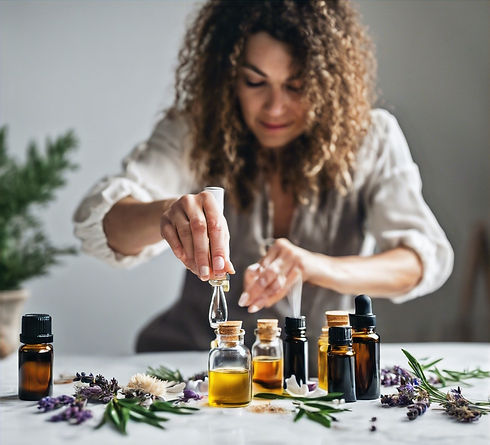
The Art of Aromatic Blends with
Essential oils
THE ART OF PERFUME MAKING with Essential Oils
Essential oils were used not only for their therapeutic properties but also for their pleasant aroma. We provide a simple description and classification so you can blend your own 100% natural parfyme.
Each of us is unique, so we will connect with fragrances differently as each person's memories surrounding that aroma will be different. Creating aromatherapy blends is a personal and creative activity, so it's helpful to remember to start off blending essential oils that you love and then branch out to creating perfume blends and natural products for others.
It's allowed to be creative. However, we recommend following a few simple rules. Following George William Septimus Piesse's (1820) classification in his book, The Art of Perfumery, one can easily create one's parfyme with a simple science in the background.
Essential oils have different strengths in aroma. Some evaporate fast, and some aromas last longer. We can divide essential oils into top, middle, and base notes based on these rules.
A good rule of thumb is 30 per cent top notes, 50 per cent middle notes, and 20 per cent base notes.
Top Notes: Essential oils classified as top notes typically evaporate very fast. They are fast-acting and usually give the "first impression" of the blend you are making.
Middle Notes: These oils give body to the blend and are balancers. The middle notes may not be immediately evident and may take a few minutes to be recognised. They are usually warm and soft smelling.
Base Notes: They usually are "heavy" oils with a quite evident and forward fragrance, but they can evolve slowly, be potent for a longer time, and slow the evaporation of the other oils. They are heady and intense-smelling and can be costly.
Blending essential oils is all about inhaling! For those new to essential oils and aromatherapy, one of the best ways to begin creating personal fragrances is by combining essential oils you love from the first inhale. Blending does not have hard and fast rules that must be followed to create that wonderful blend that you'll love for a lifetime. The lack of limits and restrictions is what makes perfumery an art form.
Remember to add only a drop of the intensely fragranced Essential Oils at a time to prevent it from overpowering your entire blend. Blending relies on the notes and the purpose, measurement, and relationship of one oil to another.
A popular blending ratio is 3:5:2: 3 parts top note oils, 5 parts middle note oils and 2 parts base note oils.
You can choose essential oils from our store. Or, would you like us to create an aromatic blending of Essential oils for you?
Essential oils were used for their aroma for centuries before the invention of artificial fragrances. Blend your personalised perfume with our Essential oils. Call for an arrangement to test which oils and blends suit you well.

Classification of the Essential oils shows which oil is Top, Middle and Base notes
Top Notes
Anise
Basil
Bay Laurel
Bergamot
Bergamot Mint
Cassie Floral
Camellia
Cherry Blossom
Citronella
Cyclamen
Eucalyptus
Galbanum
Ginger Lily
Grapefruit
Lavender
Lavendin
Lemon
Lemongrass
Lilac
Lily
Lime
Marigold Tagetes
Marjoram
Mimosa
Monardo
Orange Sweet
Orange Blood
Orange Bitter
Peppermint
Petitgrain
Spearmint
Tagetes
Tangerine
Wintergreen
Middle Notes
Bay
Black Pepper
Cajeput
Carnation
Chamomile
Cinnamon
Clary Sage
Clove Bud
Cypress
Dill
Elemi
Fennel
Fir Needle
Frangipani
Gardenia
Geranium
Honeysuckle
Hyssop
Helichrysum
Hibiscus
Hyacinth
Jasmine
Juniper Berry
Lotus
Linden Blossom
Magnolia Champaca
May Chang (Litsea Cubeba)
Melissa (Lemon Balm)
Manuka
Narcissus
Neroli
Orchid
Palmarosa
Peony
Pine
Rose Damascena
Rosemary
Rosewood
Spruce
Tulip
Tuberose
Tea Tree
Thyme
Violet Leaf
Ylang Ylang
Base Notes
Ambrette
Amyris
Angelica Root
Balsam, Peru
Benzoin
Cedarwood, Atlas
Cedarwood, Virginian
Cistus, Rockrose
Copaiba Balsam
Cypress
Davana
Frankincense
Ginger
Helichrysum (Immortelle)
Jatamansi
Myrrh
Oakmoss
Orris Irris
Osmanthus
Patchouli
Peru Balsam
Sandalwood
Spikenard
Vanilla
Vetiver

Classification by fragrance family
Floral
Bergamot
Chamomile
Geranium
Jasmine
Lavender
Linden Blossom
Neroli
Petitgrain
Palmarosa
Tuberose
Ravensara
Rosewood
Rose
Clary Sage
Ylang Ylang
Minty
Birch
Peppermint
Spearmint
Oriental / Exotic
Jasmine
Patchouli
Sandalwood
Vanilla
Ylang Ylang
Herbaceous
Basil
Carrot Seed
Chamomile
Clary Sage
Fennel
Ginger
Hyssop
Lavender
Palmarosa
Rosemary
Sage
Thyme
Spicy
Allspice
Basil
Bay
Black Pepper
Cardamon
Cinnamon
Clove
Ginger
Nutmeg
Ravensara
Fruity / Citrus
Bergamot
Citronella
Grapefruit
Lemon
Lemongrass
Lime
Mandarin
Orange (sweet)
Tangarine
Woodsy
Cedarwood
Cypress
Fir
Frankincense
Juniper
Myrtie
Pine
Sandalwood
Spruce
Earthy
Clary Sage
Frankincense
Manuka
Myrrh
Patchouli
Spikenard/Jatamansi
Vetiver

